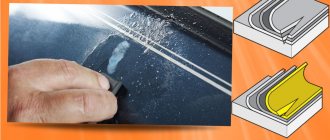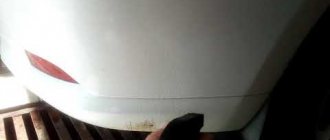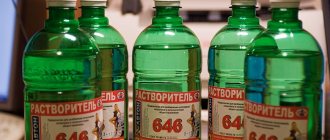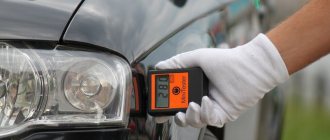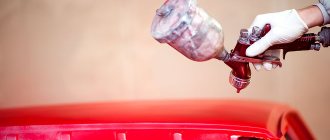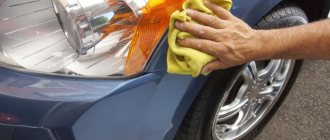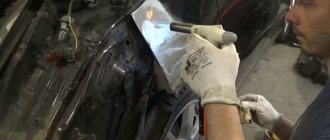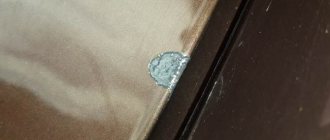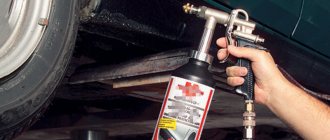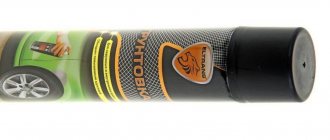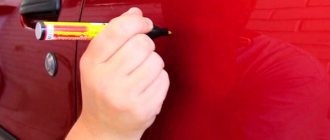The vehicle coating provides not only a presentable appearance, but also additional protection. But, like other materials, the paint surface has a limited service life. Under the influence of loads, minor damage gradually appears on it. Therefore, it will be useful for car owners to know how to paint over a scratch on a damaged car with their own hands.
Different ways to remove grooves
Small cobwebs on a car's paintwork can be removed without touching up the defect, but using the polishing method. To do this, use abrasive or wax polishes. The first type of composition removes a very thin layer of varnish until the scratch disappears, so it cannot be used frequently so as not to remove the entire protective layer from the undamaged area. Wax polishes fill the cobwebs, but after two or three washes the procedure will have to be repeated again and again.
If the protection in the form of a varnish layer or enamel is damaged, then the grooves can be covered with a wax or gel pencil; in this case, touch-up is not required. Special products in tubes or in the form of pencils are also used in cases where it is necessary to mask scuffs of the paintwork.
There is an anti-scratch product on sale in the form of special brushes for removing coating defects, which can be used to cover fairly deep grooves. The composition contains fiberglass, so its use does not require preliminary priming.
Remember that this product can only be used once, as the paint dries very quickly after opening the tube.
If the depth of the groove reaches the ground or metal, then in order to remove it, a more complex repair of the damaged area is necessary - painting over the scratches on the car. To do this, prepare the following tools and materials:
- sandpaper P1500, P2000;
- polishing paste;
- a grinding machine or drill with a set of discs;
- putty;
- rubber or plastic spatulas;
- primer;
- auto enamel color of your car;
- protective varnish;
- surface degreasing composition;
- brush, spray gun or roller.
Let's figure out how to paint over a scratch on a car with your own hands using these tools. By following step-by-step instructions, you can remove defects in your car's paintwork yourself, saving significant money.
Corrective cosmetics for the “face” of a car
Scratches that stand out brightly on the polished paint of a car are an unpleasant thing. Even more unpleasant than the rather stupid word “anti-scratch”, which has already taken root in everyday vocabulary to designate means designed to mask these very scratches as much as possible and “preserve” damage. In our rating today we will look at the best anti-scratch products that the market offers us.
What is anti-scratch in essence? In fact, it is a kind of hybrid of abrasive and finishing polishing paste. The abrasive component evens out the damaged area, smoothing out differences in the scratch area, while the wax fills them, at the same time masking them - the anti-scratch is sometimes helped by the dye introduced into the composition, which is selected as close as possible to the color of the car's paint. That is, you will get the same thing with regular polishing with several compounds in turn - just “anti-scratch” will make it faster and easier (but not better!), and it is usually sold in a small package designed for a small amount of work.
Body polishing is a cosmetic operation for a car.
First, let's look at the simplest case, when the scratches are very small and insignificant, damaging only the top layer of paint. As a rule, these damages can result from contact with pebbles or small branches.
In this case, you just need to properly polish the damaged area. Based on the tasks to be solved and the functions performed, there are two main types of cosmetic polishing of the machine:
- Abrasive polishing is the simplest method aimed not only at restoring the body, but also giving it its original beautiful appearance. The polish itself is of great importance, because preference should be given only to high-quality products. Otherwise, you can neutralize both the scratches themselves and the protective layer of paint. If you polish your car too much, you will have to perform more complex restoration work.
- Protective polishing - unlike cosmetic polishing, this category of work is aimed exclusively at restoring the paint layer of the car body. In addition to standard polishes and similar compounds, numerous mastics and special car waxes can be added here. The principle of operation of such compositions is that after application to the surface of the car, a film is formed that corrects damage, while perfectly masking it.
Polishing is carried out after applying polish to the body. Specialists usually use special equipment, for example, a grinding machine or similar equipment. But you can completely do without these devices by using fine-grained sandpaper or even a usually thick napkin if the scratch is very small and unnoticeable.
After applying the composition to the metal, you need to grind the surface using gentle circular movements. The paste must be constantly moistened, since a dry composition when rubbed into the top layer can cause additional damage. Once there is no trace left of the scratch, polishing can be completed. These actions must be performed only in warm, dry rooms where there is no exposure to external factors, including moisture, precipitation or dust.
What scratches can be removed using auto chemicals?
Before choosing a removal method, it is important to understand the nature of the impact, the depth of damage, which extends in depth to the following layers of paint:
- Lacquer.
- Enamel.
- Ground.
- Phosphate.
- Metal.
Defects are clearly visible:
Damage to the first layer can be repaired with light polishing or a scratch masking pencil. The latter is also suitable for removing damage from the enamel coating. Mechanical defects and scratches also appear on plastic, including in the interior, but they are usually shallow and easier to get rid of than on LPK.
How to remove small and deep defects with your own hands
Small and shallow scratches can be removed using regular polish. Circular lines and stains visible on the surface of the metal indicate low-quality and improperly carried out polishing. Eliminating such defects is as easy as shelling pears - an abrasive polish does not harm the paintwork and allows you to obtain a perfectly smooth and even surface.
A low-abrasive polish can handle more serious defects. With its help, you can eliminate visually invisible scratches that are easily tactilely felt.
The car body after treatment with an abrasive polish looks more presentable, but it is easy for a beginner to overdo it with pressure or choose the density of the composition
In case of serious cuts and damage, use varnish, paint and wax. They allow you to level the surface, hiding scratches. The varnish applied over the paint fixes it.
If the scratch is deep and rust appears inside it, you must first remove it cleanly, and this is mandatory! Conventional repair methods will not help here, and soon the damage will be visible again. You can find out how to treat rust and traces of corrosion in this article.
Varnishes and paints used to process individual body elements are presented in the form of small bottles with a brush. The product is applied in a thin layer to the damaged area and perfectly seals the defects. However, it is worth knowing that varnishes and waxes are temporary means that hide scratches and do not eliminate them.
We recommend: Signs of a faulty fuel pressure regulator
How to remove scratches by polishing by hand or with a machine
Minor scratches, visible only on a freshly washed and dry car, can be removed by regular surface polishing. Deeper defects that did not touch the primer layer are corrected using abrasive polishing. Such pastes remove the top layer of the coating, which makes defects invisible against the general background. These products are applied either manually using intense circular movements or using polishing machines.
If there is no tool, do all the work yourself
Restorative polishes are colorless and do not leave marks on the surface. The main requirement when processing the body is that the paste should not dry out, otherwise it will scratch the paintwork.
The polishing machine that will be used to eliminate body defects can be anything - the most important thing is that it can change the speed. Instead of such a tool, you can use a screwdriver or drill with a special attachment. The following foam pads should be used with the polishing machine:
- white is used together with coarse abrasive pastes for rough polishing;
- orange has medium hardness and is used with fine abrasive pastes;
- black is the softest, used mainly with protective abrasive pastes.
The circles can be of other colors; usually the approximate hardness is written on their body
In addition to a polishing machine and special wheels, you need to stock up on sandpaper and pastes.
Before polishing the car body, the foam circles are wetted - they must be damp. The paste is applied to the car body, not to a polishing wheel. After this, you need to polish the car body with a machine. It is better to move the tool in a horizontal direction with a slight approach to already treated areas. Scratches from the body can only be removed after heating the varnish.
When heating the surface, the polishing wheel should operate at medium speed - otherwise you can completely burn the paintwork.
Other DIY options
Polishing a car body helps to cope only with minor defects. If the damage has affected the primer layer, then it is removed using special pencils. They form a film on the damage and come in two types: wax and gel.
- Wax crayons are a lot like drawing crayons. They simply paint over the body defect, and wipe off excess wax with a soft cloth. This method of removing scratches is the cheapest and most short-lived.
- Gel pencils are more like pens or felt-tip pens. When using them, the composition is “pumped up” to the writing tip and applied to the chip or scratch. Excess product may begin to flow down the surface. The defect elimination procedure is carried out several times until the scratch completely disappears.
Pencils are not suitable for deep scratches
- Deep and wide cracks can be removed using special corrector kits. They include a bottle with a special product, car polish, several wipes and a degreaser. Such kits are manufactured by car companies, and their components can be purchased separately.
Car polishing products
In order to determine which polish for the body and interior of a car is better, we will consider three popular products that have been repeatedly tested by car owners and received the highest ratings.
Wurth Profi
This German program will allow you to repair scratches on your car using a polishing machine. It’s worth noting right away that this paste is of an abrasive type, so it is not recommended to carry out work without equipment.
To polish with this composition, it is best to purchase three types of paste:
- rough (item 893153);
- average(893154);
- small (893155).
You will also need three polishing wheels for the job. The manufacturer has thought of a system that makes it very easy to select a disc for a specific polishing paste.
- black (fur) is used for aggressive treatment with appropriate paste;
- yellow (foam rubber) is also suitable for coarse polish, but it is not so hard, so a medium paste is applied to it;
- blue (foam rubber) for medium and fine polish.
According to the instructions, removing scratches on a car using Wurth Profi begins with rough processing. Gradually, the circles change and the surface is “grouted” until all small scratches disappear from the body.
Thanks to this restoration, the surface will be resistant to reagents and sunlight.
If you want to polish without touch-up paint and there are no deep scratches on the car, then you can eliminate the treatment with a coarse abrasive compound.
ZM
The best product among domestically produced polishes is considered to be the “brainchild” of the ZM company, developed using modern American technologies. The main advantage of these compounds is the ability to polish a car with your own hands, either with or without a polishing machine.
Among the range of pastes for removing scratches from the car body, it is worth highlighting the following bases:
- Coarse paste (abrasive type) for removing deep scratches from the car body (item 09374).
- Medium-hard abrasive compound to remove scratches that do not reach the metal (09375).
- Car polish (applied by hand without a machine) without abrasive particles (09376).
- Protective paste, to add shine (09377).
ZM also offers a line of polishing wheels for each composition:
- Article 01927 – for rough processing with paste article 09374.
- 09550 – for pastes 09374 and 09375.
- 09378 – for polish 09376.
- 05729 is used when processing with 09377.
Body Compound
Body Compound scratch remover is another effective paste that quickly “reanimates” paintwork. Compared to professional counterparts, no equipment is required to use this polish. In addition, manual polishing of the body does not require the selection of several components, costing from 500 rubles each. The product contains soft abrasives, so after sealing cracks, you don’t have to worry about the paint material.
Pastes of this brand are suitable for any coating, so they are also used for car interiors, plastic elements of the dashboard and much more.
The only downside to Body Compound is that this gentle abrasive is only suitable for minor damage. In terms of durability, it is not inferior to its analogues.
You can also purchase Bravo, RM, Sonax, SIA and Meguiars to polish the car body. These pastes have also proven themselves well among car owners.
Before you remove scratches on your car with your own hands, regardless of the paste or spray you choose, carefully read the instructions and take into account some general recommendations.
Removing scratches on a car body by polishing
Polishing is one of the most effective ways to remove scratches on a car body without painting. Depending on the depth and area of damage to the paintwork, scratches can be polished manually or using a polishing machine.
- The body is manually polished with a soft cloth using polish, which can be purchased at any auto shop. You just need to follow the instructions, which are usually found on the back of the polish bottle, to relatively quickly remove minor scratches from the car body.
- It is a completely different matter to remove scratches by polishing the body using a polishing machine. In this case, you cannot do without special knowledge and equipment.
Car body polishing can be either protective or abrasive:
- With protective polishing you give your car shine and shine, while eliminating minor scratches on the car body;
- By abrasive polishing using polishing pastes, you can remove not only scratches, but also chips, abrasions and other not very serious damage to the paintwork that can be removed without painting the car.
Since the second method of polishing is quite labor-intensive and requires some skill, we recommend that you read our instructions for polishing a car body with your own hands.
Conceal damage with a lighter
Repair using open fire is similar to the previous method. To remove defects in this way, you need to hold the lighter to the plastic for a very short time and draw the flame several times along the scratch. You need to act extremely carefully; it is advisable to practice performing such repairs on some unnecessary piece of plastic with the same structure.
After exposing the accumulation of scratches to fire, you need to wait a while until the plastic cools completely. Until this moment, it is strictly forbidden to touch it. The soot left by the flame can be removed with a cotton pad soaked in alcohol. If the defect does not disappear the first time, then it is better not to risk it and try another method of removing scratches.
Scratch removal kits
The detailing industry has a lot of good products for successfully touching up chips and scratches. Special touch-up pens for touch-up transfer paint into chips and scratches by capillary action. They can really repair scratches and chips accurately.
Ready-made scratch removal kits are sold. For example, the set (3M Scratch & Scuff Removal Kit) contains everything you need to remove shallow scratches. The set includes sanding paper, polishing paste, sanding block and polishing pad.
Bottles of paint of the desired shade can be purchased from a dealer at an auto center of your car brand, or at a car cosmetics store or at a specialized store that sells body repair products.
Types of correctors for spot restoration of the body
You can find many different pencils on the market for painting over scratches on your car. Well-established manufacturers: Fix it Pro, VODOOL, Sikeo, CARPRIE, Taffeta, Motip.
Strokes with auto enamel
Externally similar to office proofreaders. They work on a similar principle. The primers are a small bottle with a brush located on the cap. There is auto enamel inside. It is applied to the scratch site. There are many shades on sale, so choosing the right color for your car paint is not difficult. You need to paint over the damage carefully, trying not to touch the excess area.
Wax
This is a universal remedy for removing minor damage to a car's paintwork. It combines polymers and several types of natural wax. There are two types of pencils. The first one resembles drawing chalk, while the second one looks like a regular marker. They are used to mask any type of defects, even the deepest ones. The wax penetrates deeply into the void created by damage and fills it, protecting the body from moisture and rust formation. The product does not wash off even after washing. Before use, it is recommended to heat the bottle to 20 C;
Kits for painting scratches and chips
Consist of several items. They include: a marker for painting, a bottle with a restoring composition. Inside the marker is a mixture of acrylic and polishing particles. When applied to a damaged part of the body, the liquid fills the space inside the scratch, penetrating into all microcracks. Polishing particles penetrate deep into the surface, preventing the development of corrosion at the defect site. The composition masks damage, returning the car to a presentable appearance;
Gel pencils
These are small size tubes. Inside them there is a gel-like substance with a thick consistency. They are designed to eliminate defects on the top layer of varnish. After application to the surface, the substance penetrates into the recess, filling it. After drying, the gel completely merges with the varnish coating, visually eliminating the defect.
How to paint over a scratch on a car
No matter how careful the driver is, scratches will still appear on the car. Damage of this type is divided into several groups depending on a number of signs:
- minor scratches of the first level that damaged the paintwork;
- medium scratches of the second level, damaging the top layer and primer;
- deep scratches of the third level, damaging all layers of the coating, including metal.
Special tools are used to paint scratches on a car. But to understand what kind of device you will need to restore the surface, you need to determine the type of scratch.
There are also several types of damage repair methods:
- spot;
- polishing;
- using a brush;
- using a can of spray paint;
- with a full renovation.
We recommend: Repair of cylinder head on Lada Priora 16 valves
In most cases, no labor-intensive effort is required to remove the scratch. To do this, it is not necessary to contact a service center - you can paint over the scratch on the damaged area yourself.
Spot painting
Spot painting is also known as retouching. This method involves several ways to restore the surface of a car, depending on the level of damage.
Most often, this type of painting is used to remove level 1 scratches that have damaged the paintwork. When performing spot painting, the locations of scratches are determined, after which painting is carried out. The task is completed independently using marker pencils.
If there are second-level scratches on the coating that have damaged the paintwork and primer, local agents are used. These include a polymer chalk pencil and a paint brush. It is recommended to apply the paint in several layers.
Paint a scratch only in clean and dry areas. You need to wait until the surface dries before applying the next coat of paint.
Polishing
If there are scratches, painting is not always necessary. In some cases, polishing is sufficient. This method is only suitable if it is necessary to remove shallow scratches. To determine their presence, you need to wet the surface and wait until it dries. After this, the scratches will appear on their own.
You can remove the scratch by polishing it yourself or at a car wash. It requires a special wax paste. The substance fills the scratch, causing it to disappear. But it should be borne in mind that polishing provides a temporary effect. Therefore, in order to maintain the paintwork in a new condition, it is necessary to periodically repeat this action.
Where do scratches come from?
If the top layer of the coating is destroyed, the car loses its natural shine. If the protective varnish layer is damaged, the sun's rays easily penetrate the paint layer, which becomes dull over time. The thinner the layer, the greater the impact weather conditions have on the paint. After some time, small cracks and delaminations appear on the surface of the body. In the absence of proper care for paintwork, damage increases in size and chips may form.
But cracks on a vehicle can appear not only as a result of natural environmental influences. Causes of damage:
- Scratches occur as a result of careless driving. Inattentive driving of a car leads to a collision with nearby cars. Some drivers inadvertently cling to the gate when leaving. During outdoor recreation, numerous defects from bush branches may remain on the body.
- Dust, dirt, stones. When driving, the vehicle body suffers from small particles that fly out from under the wheels of the vehicle in front. As a result, the varnish is scratched, and large particles can even cause chips.
- Scratches caused by careless washing. Having a car is not worth saving on things that are simply necessary for care. Do not wash your car with dirty rags or hard sponges without using car shampoo. You should know that when washed with soapy water, the abrasive effect is washed off from the body coating, and abrasions may remain from the rags.
- Cracks can occur as a result of damage to the machine by intruders. A bird might walk across the car or a cat might run across it.
Most causes can be prevented if you take good care of your vehicle.
Car paint color selection
In cases where local touch-up of a car's paintwork is done, an important point is the correct selection of paint. It is very difficult to choose a shade so that it exactly matches the color of your car. There are no questions if you know the number of the auto enamel that your car is painted with. You simply purchase the necessary consumables at a hardware store and get to work. Otherwise, to accurately select the required color for a car body, there are several methods for determining the desired shade.
- Almost every vehicle has a label on which the VIN code is indicated. It is located on the driver's door pillar, on the inside of the hood or trunk lid, in a special window on the windshield. The VIN code is also in the car's passport. Manufacturers of car paints use a common system of standard tints used in the production of vehicles, so the selection of shade according to the code will be accurate.
- Contact a car repair shop, providing the technician with information about the make of the car, its model, and year of manufacture.
- The most accurate method is computer selection, using appropriate programs that compare the codes of car enamels with the one on the sample, and also select the optimal consistency of the material, depth and saturation of the color.
- Using a fan of colors does not guarantee a 100% match with the color of your car, but it can also be used to select car paint.
After you have chosen the desired shade of paint, it is time to proceed directly to painting the car body. Before applying auto enamel, degrease the prepared area with a solvent. Painting scratches on a car takes place in 2 layers. To do this, use a brush, roller or spray gun. If you are new to this business, it will be difficult to avoid smudges. In this case, after the layer has dried, you need to sand the surface wet and paint it again.
The best protection for paintwork is varnishing. Therefore, after painting the damaged area, apply a layer of varnish. The protection will be restored qualitatively if each new layer is applied so that it overlaps the previous one with some margin, forming an even transition.
How to remove minor scratches
Small cracks in plastic can be painted over, filled with a solid substance, or sanded using various means. Let's consider each method in detail.
Polish
The polish removes scratches and cracks from matte and glossy plastic. Before use, clean and degrease the surface with alcohol or acetone. Apply polish to a soft cloth and rub gently into the scratch without pressing. Let the product dry and then polish until shiny with a dry cloth.
Do not use polish with abrasive particles - they will scratch the plastic even more.
Wax
Soft wax fills voids and smoothes the surface of the object. Clean and degrease the plastic and apply wax to the scratch. Using a soft microfiber cloth, rub the wax into the scratch and wipe off any excess with a cotton pad. You can also use a wax pencil, which you can buy at a hardware store.
Goi paste works in a similar way - it is a means of grinding and polishing hard plastics, polymers, ceramics and metals. The paste removes almost all scratches on plastic. When using this product, proceed in the same way as with wax.
Hairdryer
Plastic has a low melting point and the scratch can be carefully melted with a hair dryer. Clean and degrease the surface and direct hot air at the crack, moving up and down the entire scratch.
Be careful: if you blow a hairdryer on a scratch for a long time, the plastic may melt and the surface will become deformed. Leave to cool for 15-20 minutes and then wipe the item with a cloth.
Lighter
If the scratch is small, you can use a lighter instead of a hairdryer. Clean the surface and warm the scratch with a lighter. Then remove any remaining soot by wiping the surface with a cotton pad soaked in alcohol. Temperature methods require skills, so if you are planning to restore a valuable item, it is better to turn to professionals.
Restorative pencils
There are special pencils that paint over scratches on plastic - they will mask small and shallow damage. To paint over a scratch, you need to carefully choose the shade of the pencil, otherwise the crack will stand out.
Clean and degrease the plastic, and then carefully paint over the scratch with a pencil. Let dry and remove excess product.
Restoring the paint layer - preparation and main steps
Experienced motorists know very well that any damage to the car body can be repaired. Especially when it comes to such minor problems as scratches. Even without minimal experience in handling such damage, anyone can paint over a scratch on a car with their own hands, without visiting service stations. This saves time and, more importantly, money, since the result will be the same in any case.
Before painting a car, it is necessary to obtain some theoretical knowledge, in particular about the layers of the body surface. So, the following is the order, starting from the top:
- A layer of varnish.
- The base layer is enamel.
- Primer.
- Phosphate.
- Sheet steel is the deepest, last layer of the car body.
We recommend: 5 effective ways to get rid of foggy car windows
Depending on the layer damaged by contact with foreign bodies, the technology of restoration and restoration may differ significantly. The simplest, for obvious reasons, are scratches that only damage the paintwork. In this case, the operation to remove the damage may take a couple of minutes.
If during a trip you accidentally hit the fence and made a deep enough chip that touched the steel, then you will need to put in much more effort. But, we repeat, any damage of this nature, regardless of its depth, can be corrected at home.
Restoring the appearance of a scratched bumper
Scratches on the bumper are removed using the same methods as on the body.
Removing scratches on a car is carried out not only on body parts. Although car bumpers are made of impact-resistant plastic, they are also susceptible to minor damage.
Scratches affecting only the paintwork are removed in the same way and using the same materials as on the body. If the defect has reached the plastic, then polishing will not help. You can restore a damaged area by first removing the layer of paint and varnish around it. Shallow penetrations into plastic are sanded with sandpaper; deep - filled with putty. Then the bare area is covered with a primer and painted. Plastic is not subject to corrosion, so mistakes during painting will not lead to fatal damage.
Options for eliminating shallow and severe damage
Car body defects can be removed in different ways, many of them are used in service centers. These include:
- polishing;
- restoration of paintwork;
- use of special tools.
The listed methods of body treatment can eliminate almost any type of damage.
To polish and grout the body, various power tools are used - drills with attachments, screwdrivers and grinders. However, they are used only as a last resort, when it is necessary to deal with obvious corrosion and rust.
Not every car enthusiast can afford to purchase such a tool, so other options for polishing tools can be used, even manual polishing
To eliminate damage to the body, accessories are also used - rough rags, brushes, soft rags. All protective equipment is divided into several types:
- regular or non-abrasive polish;
- special paint;
- colored wax and pencils;
- colorless varnish.
Pencil for touching up chips and scratches
Any car owner will always be happy to minimize the cost of maintaining his car. One of the most unexpected expenses is paint repairs. From our rich car service experience, we draw a conclusion and suggest it to you - the main troubles and problems of a vehicle’s paintwork begin with chips. More precisely from neglected chips. We are always in a hurry and stop only when it becomes embarrassing or sometimes unsafe to drive a rusty car. Dear friends, on the page dedicated to repairing chips using materials in bottles with a brush, we tell you how to use this type of paint repair. You need to understand that painting with a brush provides a thick layer of transfer of paint and varnish material and is used for more extensive and deep chips and scratches, possibly with initial foci of corrosion. If the chip is fresh, there are no pockets of corrosion, and the paintwork is not damaged to the metal, then it is advisable to use special pencils (markers, felt-tip pens) to touch up chips and scratches. Our laboratory tints the paint according to your car code or RAL and fills it into aerosol cans, bottles with a brush, as well as special reusable pencils for touching up chips. Making and adding paint to a pencil takes no more than 10 minutes.
Why are pencils useful for touching up chips? Firstly, it is easy to use: open the cap, draw a line or make a dot, close the cap - the chip or scratch is neutralized. Secondly, this is the cleanliness of the repair: there is no need to be afraid that the paint will drip from the brush where it does not need to drip or cause a smudge at the repair site. Thirdly, it is easy to store: the pencil for touching up chips and scratches is compact and durable because it is made of iron. Yes, yes, dear friends, the body, also known as the reservoir for the paint and varnish material of the pencil for touching up chips, is made of aluminum. Unlike plastic pencils, the metal body prevents premature drying of the paint and has a significantly larger volume. Even if, during long-term storage, the paint in the pencil for repairing chips and scratches has thickened, you can easily drop a couple of drops of solvent into it, and the pencil for touching up your car will be like new again. And one more nice thing: if you buy a pencil for tinting a car, you can easily refill it with paint as you use it.
The technology for touching up chips and scratches using a scratch removal pencil is extremely simple. A scratch or chip, if it is down to the ground, is degreased with anti-silicone. We have it on sale in micro containers with a brush. Next, we go over the scratch or chip with a pencil with paint and on top with a pencil with varnish. That's it, you can go. You need to get into the habit of conducting a quick inspection of the paintwork after each car wash, and immediately eliminate all small chips and scratches with the paint and varnish pencils you have for touching up chips while the car is clean.
Cost of a repair kit for repairing chips and scratches on a car:
If the damage to the car's paintwork is significant, then in this case the repair is carried out with aerosol materials, which are always available in our store, and which we can tint to match the color of your car or the RAL color system.
How to buy
Dear friends! Remember that the Color Laboratory technologists will always and with pleasure advise you on any issues regarding painting technology.
Tips for removing scratches with partial body touch-up
If there is deep and extensive damage to the paintwork, it would be more advisable to remove scratches on the car body using paint and varnish. They are available at retail in small bottles and are designed specifically for local correction.
But in addition to some labor-intensiveness of this process, you will also need to work hard on selecting the desired color and shade of paint (see the video below).
In cases of significant damage to the paintwork, which has reached the “living” metal, before removing scratches from the car body, you need to treat the damaged surface with a rust converter or apply a protective zinc coating (for details, see the article on rust removal) - this will prevent subsequent corrosion of the metal. Only after this operation has been completed will it be possible to use paint and varnish.
If, due to the degree of damage to the paintwork, you need to use putty, do not neglect this procedure. It is advisable to entrust all complex work to qualified specialists who will competently carry out restoration work and help achieve an impeccable result.
However, if you have “straight” hands and some experience, you can independently remove almost any scratches from the car body (both without painting and with touch-up of the damaged areas). It is worth taking into account that all work must be carried out in a clean, dry and warm room with sufficient lighting. Before starting touch-up painting, it is advisable to warm up the car body.
Well, if things are really bad, then we highly recommend that you read the detailed instructions for painting a car yourself.
What is LCP?
First, you need to understand what a car’s paintwork is. Everyone knows that this is the coating of a car body using paint and varnish. In addition to adding aesthetics to the vehicle, the paintwork system is designed to prevent premature destruction of the metal due to corrosion.
The paint coating system includes the following categories of layers:
- Primer. The primer contains substances that are resistant to temperature changes and minor deformations. Among this category there are acrylic (used for repair and restoration work on the body), epoxy (have anti-corrosion properties) and acid (used before painting the body and are designed to prevent metal oxidation).
- Intermediate. This layer is responsible for the body color. Among car enamels, there are acrylic (dries quickly, does not shrink, is resistant to mechanical damage, does not deteriorate when changing atmospheric conditions), alkyd (a budget option, less polished, difficult to achieve a mirror effect; car painters recommend them for local work), metallics (in their The composition includes aluminum powder, which gives the body an original shine). Some types of paints do not require the use of varnishes. Special types of paints have been created for rims and bumpers.
- Covering. The purpose of the varnish coating is to protect the base layer from ultraviolet rays and aggressive weather conditions. There is a huge variety of car polishes. The list includes acrylic (requires adherence to application technology, dries quickly), cellulose (practically not used for repair work), glyphthalic (contains synthetic resins that provide elasticity to the protective layer), polyurethane (resistant to brake fluid, gasoline and acid ), acrylic polyurethane (two-component varnishes with the properties of acrylic and polyurethane analogues).
Each manufacturer uses different materials at the stage of treating the body with protective agents, which may differ from analogues in chemical composition. The more durable the coating, the less corrosion the car body will be subject to.
That is why every motorist needs to keep his car clean and be attentive to the appearance of scratches on the paint.
How to repair many scratches?
More serious damage, consisting of a whole series of scratches, may need to be touched up using a spray can (or a spray gun, if possible). If you repair several adjacent scratches using the methods described above in this article, then after repair they will be more noticeable than one repaired scratch.
Car bumpers often receive damage in the form of multiple scratches. The bumpers, especially the front ones, are shaped in such a way that the repaired damage can be touched up with a spray can and the border with the rest of the bumper will be barely noticeable.
For example, if the lower side part of the bumper is damaged (as in the photo), you will need to fill the scratches with putty, sand, prime (you can use a spray can), prepare the primer and a small adjacent area by sanding and paint with a spray can. In this case, you need to seal the adjacent surfaces that are not to be painted with masking tape and newspapers (the painted part of the bumper does not need to be sealed so that there is no visible transition border).
If the original paint is varnished, then during repairs you can use paint, and varnish on top of it. If you match the paint to the color of the car (in some stores it is possible to select paint and pour it into a can), then the repair will be unnoticeable. You can read about how to spray paint correctly in the article “Spray painting a car.”
Pros of using paint pencil
The main advantages of this option include relatively low cost (when compared with the services of car workshops) and ease of use. This is because this option can be used for a long period of time.
Another advantage is the ability to independently, quickly, but at the same time, in most cases, effectively use this option.
In addition, it is quite acceptable to carry a pencil with you all the time and quickly use it when the need arises.
How to use a wax pencil correctly
Repairing chips and scratches on a foreign or domestic car has a number of nuances:
- Before removing scratches and chips, you must thoroughly wash and degrease the work surface. Do not use gasoline or thinner as a degreaser. After drying, begin applying the product.
- You need to take a break during processing. It is necessary for drying the substance and visually assessing the intermediate results of the work.
- Large chips are painted over several times.
If you do not follow the recommendations for restoring a car's paintwork using a wax pencil, the result of the work performed will be unsatisfactory.
Other additional means of getting rid of scratches
After treating the scratch with a pencil or gel, you need to fix the result, and you can improve it with polish. Here too the choice is huge.
Take a closer look at the compositions described below:
- 3M Synthetic Wax Protectant. American synthetic polish. Its main feature is the formation on the body after processing of a thick protective layer that protects the paintwork from small stones, abrasive dirt, as well as UV radiation and chemicals. As a final step, buff the area with microfiber. Estimated cost - 900 rubles.
- Turtle Wax plus PTFE. The peculiarity of this polish is the presence of Teflon in its composition, which protects paintwork from fading, chemically active environments, moisture, and dirt. Sold in 300 ml cans, which is enough for at least a couple of treatments of the entire car body, not just scratches. Approximate price - 300 rubles.
- Soft99 Water Block Wax Gloss Type. Polish from Japan. Its main advantage is its water-repellent properties, due to the presence of wax in the composition. When applied, at the initial stage a whitish film is obtained, which must be rubbed in a circular motion using microfiber. When moisture gets on a body treated with Soft99 Water Block Wax Gloss Type, the water simply rolls off it in the form of drops. The manufacturer guarantees a 3-month validity period for one treatment (20-30 coatings). Cost - from 1600 rubles.
- Nanox Carnauba NX8305. Synthetic wax polish. Has a soft consistency. First, the composition is applied to a sponge, which must first be moistened with water. The product has the greatest effect in terms of increasing the saturation of body color. Container volume - 227 ml, price - from 700 rubles.
Using pencils or markers to eliminate scratches, it is recommended to polish the damaged area at the final stage. This will provide additional protection from external atmospheric influences, make the body color more saturated and aesthetically attractive. Do not forget to strictly follow the manufacturer's instructions for both car pencils and polishes.
If you have any questions, leave them in the comments below the article. We or our visitors will be happy to answer them
